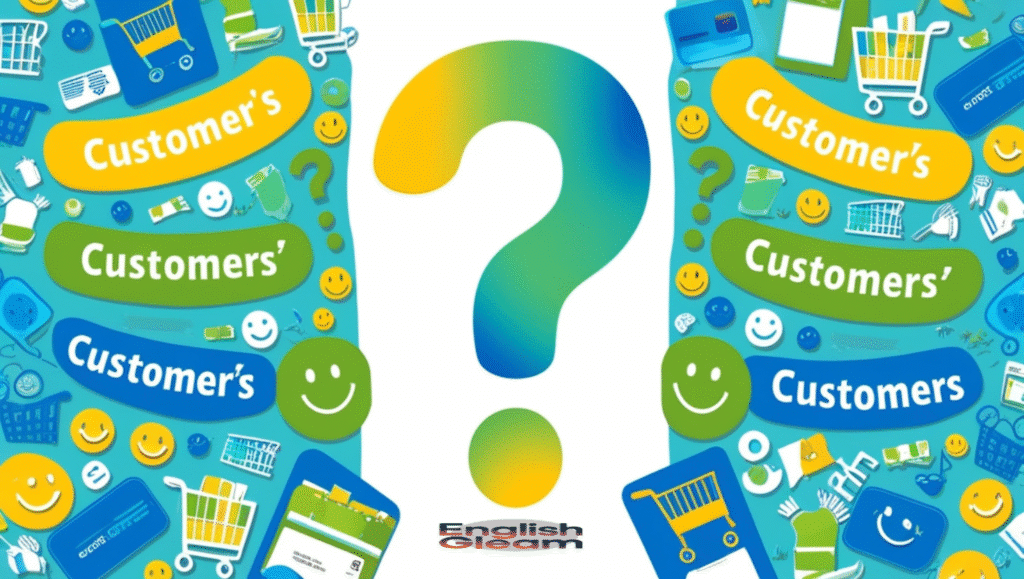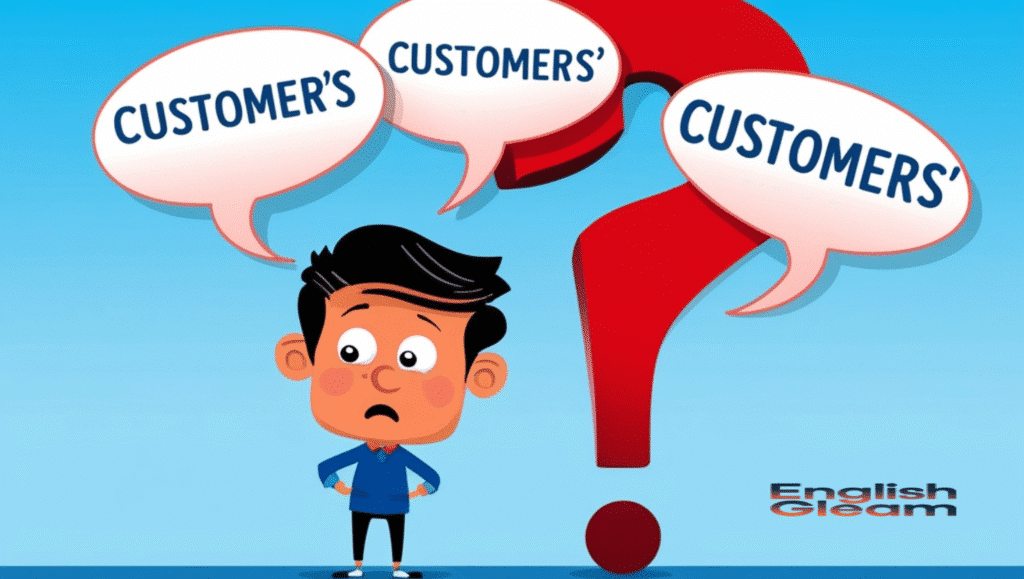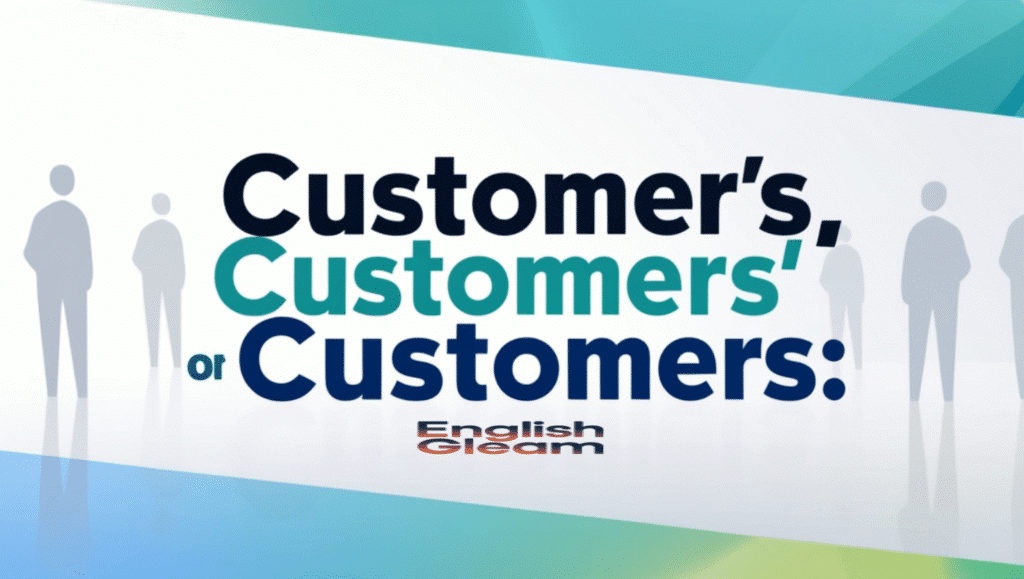Customer’s, Customers’, or Customers are different grammar forms. They show if you’re talking about one person, many people, or what they own. Using the right one helps your message make sense.
Ever get confused about where to put the apostrophe? You’re not alone—it happens to many people. Let’s make it easy and fix that confusion now.
These small grammar forms matter in business too. They show who owns what in clear ways. They also improve your customer communication.
Table of Contents
- What Are Possessive Forms?
- The Difference Between Customer, Customer’s, and Customers’
- Why Apostrophes Matter in Business Writing
- Singular vs. Plural Possession Explained
- Real-World Examples in Customer Service and Branding
- Avoiding Grammar Mistakes That Hurt Your Image
- Quick Reference Table: Customer Forms at a Glance
- Practical Usage in Digital Communication
- FAQs on Possessive Grammar
- Final Thoughts: Professionalism Starts with Precision
What Are Possessive Forms?
Possessive forms show ownership or relationship. In grammar, they help us understand who owns what. They’re a key part of grammar skills, especially in professional writing and customer communication.
Possessive nouns use apostrophes to show that something belongs to someone or something.
For example:
- The customer’s complaint (belongs to one customer)
- The customers’ reviews (belong to multiple customers)
These aren’t just grammar rules. They’re tools that shape how readers interpret your message.
Also read : 30 Other Ways to Say ‘The Author States’ (With Examples)
The Difference Between Customer, Customer’s, and Customers’
Let’s clear up the confusion with definitions and examples.
| Form | Meaning | Example Usage |
|---|---|---|
| Customer | Singular, no possession | The customer ordered a drink. |
| Customer’s | Singular possessive (one owner) | The customer’s opinion matters. |
| Customers | Plural, no possession | The customers were satisfied. |
| Customers’ | Plural possessive (more than one owner) | The customers’ expectations were high. |
This distinction is vital in customer service and digital communication, where every word carries weight.
Why Apostrophes Matter in Business Writing
Precision matters. Your choice between customer’s and customers’ can change the meaning of your sentence.
Imagine writing:
- The customers feedback was appreciated. ❌ (Wrong: missing apostrophe)
- The customer’s feedback was appreciated. ✅ (One customer)
- The customers’ feedback was appreciated. ✅ (Many customers)
This is more than a grammar issue—it’s about clarity and credibility. Inaccurate writing can:
- Confuse readers
- Lower your service quality perception
- Affect customer satisfaction
- Undermine your professional tone

Singular vs. Plural Possession Explained
Understanding the singular possessive (customer’s) versus the plural possessive (customers’) is the key to mastering these terms.
Singular Possessive – Customer’s
Used when referring to something that belongs to one customer.
Examples:
- The customer’s name was misspelled.
- We responded to the customer’s inquiry within 24 hours.
This form highlights individual attention, often essential in client support or personalized marketing.
You also might like : Witness’ or Witness’s or Witness?
Plural Possessive – Customers’
Used when the item belongs to more than one customer.
Examples:
- The customers’ lounge is located on the second floor.
- We analyzed the customers’ feedback for trends.
Here, you’re addressing the collective voice of your audience. It’s crucial for high-level business communication and market analysis.
Real-World Examples in Customer Service and Branding
Let’s see how this grammar applies to actual business situations.
1: Email Campaigns
- Incorrect: The customers order has shipped.
- Correct: The customer’s order has shipped. (one)
- Also correct: The customers’ orders have shipped. (many)
2: Customer Reviews
- Singular: The customer’s review was glowing.
- Plural: The customers’ reviews helped shape our new service.
3: In-Store Signs
- Incorrect: Customers satisfaction guaranteed.
- Correct: Customer’s satisfaction guaranteed. (if referring to each individually)
- Better: Customers’ satisfaction guaranteed. (referring to all customers)
Avoiding Grammar Mistakes That Hurt Your Image
When writing professional documents, even small grammar mistakes can damage your credibility. These common errors trip up even experienced writers:
1: Apostrophe Misplacement
- Wrong: The customers’ feedback was insightful. (when referring to just one)
- Right: The customer’s feedback was insightful.
2: Apostrophe Overuse
- Wrong: Customer’s are important.
- Right: Customers are important. (No possession, so no apostrophe needed)
3: Confusing Plural with Possessive
- Wrong: The customer’s are waiting.
- Right: The customers are waiting.
Check it : 30 Synonyms of Sigma: Alternative Terms and Their Meanings
Quick Reference Table: Customer Forms at a Glance
| Use Case | Correct Form | Why It’s Correct |
|---|---|---|
| One person owns something | Customer’s | Singular ownership (apostrophe + s) |
| Many people own something | Customers’ | Plural ownership (s + apostrophe) |
| Talking about people only | Customers | Plural form, no possession involved |
Practical Usage in Digital Communication
In the age of online messaging and social media, grammar rules still apply. Using the wrong form in a tweet, chatbot message, or promotional email can lead to:
- Misunderstood offers
- Brand embarrassment
- Lower user experience scores
Pro Tip: When in doubt, read the sentence out loud to see what makes sense.
Examples from Digital Platforms
- Social Media Post:
- “Our customers’ stories inspire us.”
- Email Subject Line:
- “Your customer’s package has shipped!”
- Website CTA:
- “See how our customers benefit from faster service.”

FAQs on Possessive Grammar
Q1. What’s the difference between customer’s and customers’?
Customer’s is for one person. Customers’ is for many.
Q2. Can you ever use customers without an apostrophe?
Absolutely! Use customers when you’re not showing ownership, just referring to people.
Q3. How do I avoid apostrophe errors in emails and reports?
Use grammar tools, but also double-check for apostrophe usage in any sentence showing ownership.
Q4. Why is this important in customer service?
Because mistakes can affect client support, brand voice, and customer expectations.
Q5. What are the most common grammar mistakes in business writing?
Apostrophe errors, confusing plural possessive and singular possessive, and misusing basic grammar rules.
Final Thoughts: Professionalism Starts with Precision
Nailing the difference between customer’s, customers’, and customers isn’t just for grammar nerds. It’s for marketers, support agents, brand managers, and anyone writing to customers.
Clear, polished language builds trust. It shows you’re detail-oriented and that you respect your readers—which directly feeds into customer satisfaction and service quality.
So next time you’re writing:
- Take a moment to identify who owns what
- Choose your possessive form wisely
- Double-check that apostrophe
Your words matter. And when they’re crafted well, they work harder for your brand.
Summary Table
| Term | Type | Example Sentence |
|---|---|---|
| Customer | Singular | The customer left a review. |
| Customer’s | Singular Possessive | The customer’s idea improved the product. |
| Customers | Plural | The customers enjoyed the new layout. |
| Customers’ | Plural Possessive | The customers’ suggestions changed the campaign. |
Conclusion:
Using customer’s, customers’, and customers correctly can improve your writing and business messages. These forms may look alike, but each one shows a different meaning. One small mark—the apostrophe—can change everything.
Clear grammar helps people understand you better. It also shows that you care about good communication. Whether you’re writing for work or school, always check the form you use. Small grammar mistakes can confuse readers. So learn the difference, keep it simple, and write with confidence every time.

William Jams is an experienced blogger at EnglishGleam, passionate about language, writing, and storytelling. With years of expertise in crafting engaging content, she aims to inspire readers through insightful articles that enhance their English skills and knowledge.






